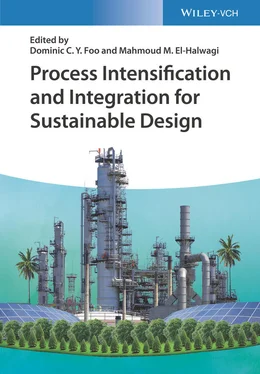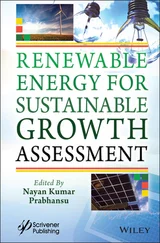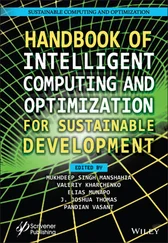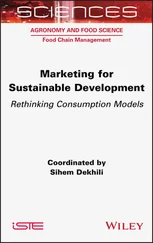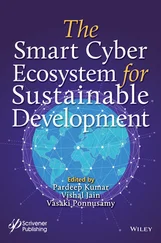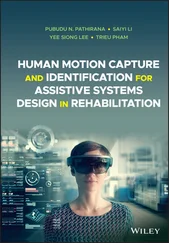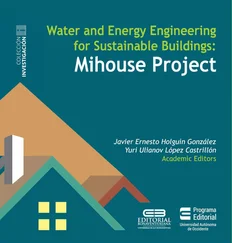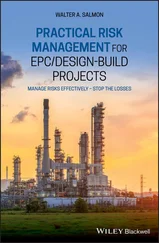1 Cover
2 Process Intensification and Integration for Sustainable Design Process Intensification and Integration for Sustainable Design Edited by Dominic C. Y. Foo MahmoudM. El-Halwagi
3 Copyright Copyright Editors Dominic C. Y. Foo University of Nottingham Malaysia Department of Chemical and Environmental Engineering Broga Road 43500 Semenyih, Selangor Malaysia Mahmoud M. El‐Halwagi Texas A&M University Department of Chemical Engineering 3122 TAMU Room 200 TX United States All books published by Wiley‐VCH are carefully produced. Nevertheless, authors, editors, and publisher do not warrant the information contained in these books, including this book, to be free of errors. Readers are advised to keep in mind that statements, data, illustrations, procedural details or other items may inadvertently be inaccurate. Library of Congress Card No.: applied for British Library Cataloguing‐in‐Publication Data A catalogue record for this book is available from the British Library. Bibliographic information published by the Deutsche Nationalbibliothek The Deutsche Nationalbibliothek lists this publication in the Deutsche Nationalbibliografie; detailed bibliographic data are available on the Internet at < http://dnb.d-nb.de >. © 2021 WILEY‐VCH GmbH, Boschstr. 12, 69469 Weinheim, Germany All rights reserved (including those of translation into other languages). No part of this book may be reproduced in any form – by photoprinting, microfilm, or any other means – nor transmitted or translated into a machine language without written permission from the publishers. Registered names, trademarks, etc. used in this book, even when not specifically marked as such, are not to be considered unprotected by law. Print ISBN: 978‐3‐527‐34547‐2 ePDF ISBN: 978‐3‐527‐81870‐9 ePub ISBN: 978‐3‐527‐81872‐3 oBook ISBN: 978‐3‐527‐81873‐0 Cover Design Adam-Design, Weinheim, Germany
4 dedication-page Dominic C. Y. Foo would like to dedicate this book to his wife Cecilia and kids Irene, Jessica, and Helena. Mahmoud M. El‐Halwagi would like to dedicate this book to his parents, his wife Amal, and sons Omar and Ali.
5 Preface Preface The chemical process industry involves a broad spectrum of manufacturing sectors and facilities around the world. With increased global competition, escalating environmental concerns, dwindling energy, and material resources, it is imperative for industry to seek continuous process improvement. Process intensification and integration are among the most effective strategies leading to improved process designs and operations with enhancement in cost effectiveness, resource conservation, efficiency, safety, and sustainability. Process integration is a holistic framework for designing and operating industrial facilities with an overarching focus on the interconnected nature of the various pieces of equipment, mass, energy, and functionalities. On the other hand, process intensification involves efficiency improvement through effective strategies such as increasing throughput for the same physical size or decreasing the physical size for the same throughput, coupling units and phenomena, enhancing mass and energy utilization, and mitigating environmental impact. There is a natural synergism between process integration and intensification. For instance, mass and energy integration (two key pillars of process integration) are ideal approaches for enhancing mass and energy intensities. This book is intended to provide a compilation of the various recent developments in the fields of process intensification and process integration with focus on enhancing sustainability of the chemical processes and products. It includes state‐of‐the‐art contributions by world‐renowned leaders in process intensification and integration. It strikes a balance between fundamental techniques and industrial applications. Both academic researchers and industrial practitioners will be able to use this book as a guide to optimize their respective plants and processes. The 14 chapters in the book are classified into two broad areas: process intensification and process integration. As expected, several intensification chapters include integration and vice versa. These chapters may be read independently of each other, or with no particular sequence. Synopses of all chapters are given as follows.
Section 1 – Process Intensification Section 1 – Process Intensification The first section of the book consists of six chapters focusing on process intensification. Chapters 1 and 2 focus on process intensification for the shale gas industry. Chapter 1 entitled “Shale Gas as an Option for the Production of Chemicals and Challenges for Process Intensification” (by Ortiz‐Espinoza and Jiménez‐Gutiérrez ) discusses alternatives to produce chemicals from shale gas, and opportunities for process intensification. In Chapter 2 entitled “Design and Techno‐Economic Analysis of Separation Units to Handle Feedstock Variability in Shale Gas Treatment” (by Bohac and coworkers ), a systematic approach is proposed for the design of a processing plant to treat raw shale gas with variable composition. Chapters 3 – 5 focuses on various process intensification aspect of membrane separation processes. In Chapter 3 entitled “Sustainable Design and Model‐Based Optimization of Hybrid RO–PRO Desalination Process” (by Lu and coworkers ), a dimensionless model‐based optimization approach was developed to evaluate the performance of a hybrid systems consisting of reverse osmosis and pressure retarded osmosis processes. In Chapter 4 , entitled “Techno‐Economic and Environmental Assessment of Ultrathin Polysulfone Membranes for Oxygen‐Enriched Combustion” (by Lock and coworkers ), multiscale simulation was used for techno‐economic feasibility study of ultrathin polysulfone membrane for oxygen‐enriched combustion; the multiscale simulation covers molecular scale, mesoscale, and eventually process optimization and design. Chapter 5 , entitled “Process Intensification of Membrane‐Based Systems for Water, Energy, and Environment Applications” (by Md Nordin and coworkers ), outlined three important applications of membrane technology in process intensification, i.e. membrane electrocoagulation flocculation for dye removal, membrane diffuser in photobioreactor, and forward osmosis/electrolysis. Chapter 6 , entitled “Design of Internally Heat‐Integrated Distillation Column (HIDiC)” (by Harvindran and Foo ), discussed the use of process simulation software for the design of an internal HIDiC.
Section 2 – Process Integration
6 1 Shale Gas as an Option for the Production of Chemicals and Challenges for Process Intensification 1.1 Introduction 1.2 Where Is It Found? 1.3 Shale Gas Composition 1.4 Shale Gas Effect on Natural Gas Prices 1.5 Alternatives to Produce Chemicals from Shale Gas 1.6 Synthesis Gas 1.7 Methanol 1.8 Ethylene 1.9 Benzene 1.10 Propylene 1.11 Process Intensification Opportunities 1.12 Potential Benefits and Tradeoffs Associated with Process Intensification 1.13 Conclusions References
7 2 Design and Techno‐Economic Analysis of Separation Units to Handle Feedstock Variability in Shale Gas Treatment 2.1 Introduction 2.2 Problem Statement 2.3 Methodology 2.4 Case Study 2.5 Discussion 2.6 Conclusions Appendices Appendix A: Key Parameters for the Dehydration Process Appendix B: Key Parameters for the Turboexpander Process Appendix C: Key Parameters for the Fractionation Train Appendix D: Key Parameters for the Acid Gas Removal System References
8 3 Sustainable Design and Model‐Based Optimization of Hybrid RO–PRO Desalination Process 3.1 Introduction 3.2 Unit Model Description and Hybrid Process Design 3.3 Unified Model‐Based Analysis and Optimization 3.4 Conclusion Nomenclature References
Читать дальше
